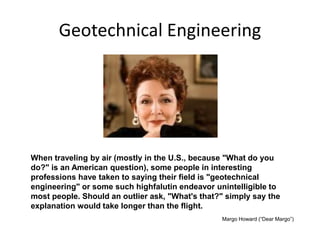Geotheta Fundamentals Explained
Geotheta Fundamentals Explained
Blog Article
A Biased View of Geotheta
Table of ContentsThe Ultimate Guide To GeothetaThe Greatest Guide To GeothetaFascination About GeothetaThe 20-Second Trick For Geotheta
They work together with civil designers, architectural engineers, engineers, and various other specialists to integrate geotechnical factors to consider right into the overall job design and construction process. This requires efficient team effort, sychronisation, and interaction to make sure that the geotechnical elements line up with the task objectives and fulfill regulative requirements.Mining & Products Design: Principles of boring, penetration rates, and variables impacting the selection of drilling technique. Blasting methods in surface area and underground functions. Mechanical and continual methods to fragmentation, including longwall shearing and fullface boring.
Integrated analysis of fragmentation and comminution operations. Provided by: Mining & Products Engineering.
An Unbiased View of Geotheta
Bachelor's level programs in civil, geotechnical, geological, and ecological design usually last four years and include general education courses in English, social science, and the humanities, along with training courses in innovative maths, architectural geology, and fluid mineralogy. (https://www.awwwards.com/geotheta/)
Geotechnical design entails the assessment of the soil and rock conditions at a specific website, and their effects for the development of that site. As many frameworks rely upon the ground for support, it is without shock that a detailed understanding of the ground conditions, and the suitability of structure systems, are important to the long-lasting security and performance of the structure or framework.
Being experts in the examination of geological developments and ground behaviour, geotechnical engineers perform clinical examinations and testing to understand the effect these geological developments may have on the layout and building and construction of structure, civil and infrastructure projects. This expertise is essential for the style and building of buildings, roads, tunnels, dams, bridges, and supply of water and sewage systems.
The geotechnical team at Douglas Partners routinely seek advice from with engineers, layout designers, designers, and building contractors to make referrals on layout and growth proposals to ensure that the built frameworks are accordingly created for the ground conditions. For example, the style of footing systems requires to take into consideration the weight of the structure, the ability of the ground to sustain that weight along with motion tolerances and efficient building.
Little Known Questions About Geotheta.
This task is greatly simplified by the use our Douglas Map geospatial platform which makes this details readily obtainable in a simple to make use of web internet browser interface. A geotechnical engineer will guide the drilling of boreholes and test pits to accumulate soil and other examples, and additionally examine surface features and ground direct exposures to create a geotechnical model of the subsurface conditions.
Relying on the task type and ground conditions ran into, laboratory testing might among other points assess stamina, compressibility, sensitivity and/or leaks in the structure of dirt and rock samples. Hereafter information is accumulated and looked at, the results are utilized for a geotechnical design of the website, which is generally presented as areas throughout the site.

A geotechnical examination naturally can just analyze the ground problems at the locations pierced or dug deep into. All-natural variants in dirt and rock problems can take place across a site and between test places. It is as a result great technique that the geotechnical designer be preserved throughout construction of the project to offer on-site verification that the ground conditions experienced are regular with the assumptions and suggestions given in the geotechnical examination record.
Fascination About Geotheta
Geotechnical engineers use their comprehensive expertise of soil and rock to evaluate risk and address issues on diverse framework projectsGeotechnical engineering is a specialist branch of civil design which takes a look at the you can try this out behaviour of planet materials and the application of dirt and rock mechanics. Engineer of Record. As a geotechnical engineer, you will certainly evaluate the physical, mechanical and chemical residential or commercial properties of dirt and rock in order to create structures, maintaining structures and earthworks
Geotechnical engineering is very closely connected to and overlaps with, both engineering geology and ground design - https://geotheta-46958753.hubspotpagebuilder.com/blog/unlocking-the-future-with-top-notch-geotechnical-engineers-at-geotheta. It's feasible to be experts in geotechnics or work for a geotechnical business but be known as an engineering geologist or a ground designer. As a geotechnical engineer, you'll need to: construct and maintain relationships with customers and other professionals entailed in the website, throughout each projectmaintain security requirements on website be mindful of price effects when you make recommendationsstudy geological maps and airborne photographs from a variety of sources and from different time periodsexamine building and construction prepares to see how viable they are based upon your understanding of the siteinvestigate risks or geological hazards for the sitesearch for eco sensitive attributes, such as garbage dump beginning to establish valid and interpretive ground modelsplan field investigationsdrill and evaluate examples of bedrock, soil, groundwater and added materials manage other specialists on sitesolve technical concerns as they arise, such as unanticipated structures at drill sitesmonitor conditions throughout and after building to see to it structures are steady in the brief and long termadding information collected on site to your first researchcreating geotechnical calculations, illustrations, and 2 or three-dimensional computer system designs analyzing the datamaking recommendations regarding the proposed use the website

Report this page